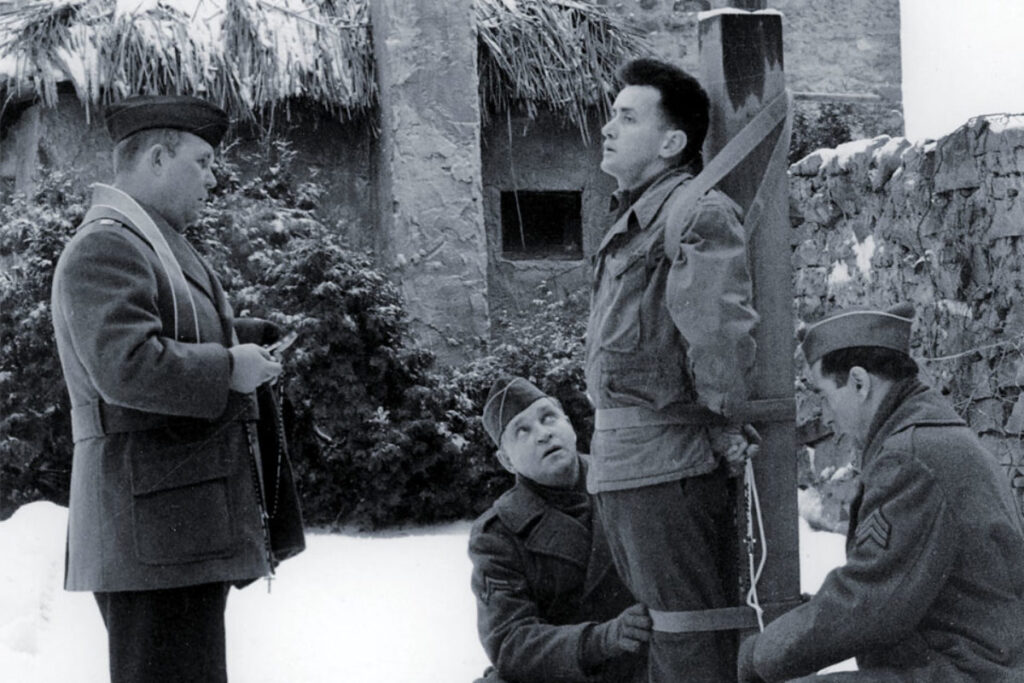Spare a moment at 09:14 am GMT today to remember Eddie Slovik. Seventy-five years ago, on January 31, 1945, Private Slovik was executed by firing squad. A total of some American GI’s deserted their post, receiving a range of punishments, but Slovik became the only one to die. The arbitrariness of his death has echoes through generations of the American executioner.
Slovik was a Polish-American who found himself in France in 1945. When he deserted, he wrote a note explaining that “[t]hey were shelling the town and we were told to dig in for the night. The following morning they were shelling us again. I was so scared, nerves and trembling, that at the time the other replacements moved out, I couldn’t move. I stayed there in my fox hole till it was quiet and I was able to move.” When he later turned himself in for desertion, two officers advised him to tear the note up and when he refused, one wrote on the back that he understood it could be used against him in his court martial. Sure enough, it was.

A later review of the decision making of the officers who imposed and later ratified the death sentence revealed that when the sentence was imposed there was little expectation that it would be carried out. However, by the time Slovik’s plea for mercy reached the desk of General Eisenhower in December, the Battle of the Bulge – the last attempt by the Germans to turn the tide – was at its height, and Allied desertions were mounting with the casualties. It is said that he felt the need to ratify the death sentence “to encourage the others”.
Slovik was sent back to his own unit to be killed, to the surprise of General Norman D. Cota, Commander of the 28th Division. Of the 12 members of the execution detail one had a blank so they would all have psychological deniability. They were meant to aim to kill, though, and Slovik was hit by eleven bullets. But only four would have been fatal, and one hit the shoulder and two the arm. An Army physician determined Slovik had not been immediately killed, but he died, at 24 years old, before the firing squad reloaded.
Hence he became not just the only GI in World War Two, he became the first and last person since the end of the Civil War to die for desertion. The randomness is not so different today’s death penalty: in 2018 there were 15,498 murders in the U.S., with just 25 executions carried out. The broader point, though, which gives its name to the “Slovik Syndrome” is absent sense of responsibility among those imposing a death sentence – a constant passing of the buck.
I was – horrifyingly! – allowed to try a capital case in 1985, just one year out of law school. I barely knew my way to the courthouse let alone what to do once I got there. The unfortunate victim of my ignorance was John Pope, who was unsurprisingly sentenced to death. In the U.S. we are allowed to talk to the jurors about their decision: of the twelve, not a single person thought John would, or even should, be executed but they were very concerned about him being paroled on a life sentence in the minimum seven years. They thought a death sentence would result in a couple of decades of appeals before it would be overturned, so John would spend twenty years in prison before being released in his sixties.
The appellate courts prefer to ignore such realities. The elected judges on the state courts often expect the federal courts to take the heat for throwing out a death sentence in a highly charged local case – at the time, the Georgia Supreme Court affirmed well over ninety percent of death sentences. The federal court of appeals then says that they will not reverse unless there is already a clear Supreme Court precedent that requires it. The Supreme Court, in turn, opines that a decision upholding a death sentence is an exercise in respect for the State court system – who, they say, are we to disagree?
In other words, nobody ever takes true responsibility for the horror they unleash – any more than anyone did in the shooting of Private Eddie Slovik. The Slovik Syndrome teaches us that they just pass the parcel until it lands in the hands of the executioner. All of this is done in the name of the mythological God of Deterrence.
In common with other victims of the firing squad, Eddie Slovik was buried in a grave in the corner of a military cemetery, identified only by a number. It was not until 1987, after the death of his wife Antoinette, that the local community raised $5,000 to bring his remains back to Detroit for burial next to her. May they both rest in peace.
